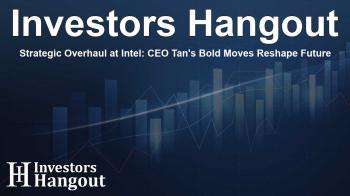Strategic Overhaul at Intel: CEO Tan's Bold Moves Reshape Future

Transformative Steps by Intel's New CEO Lip-Bu Tan
Intel Corp.'s new CEO, Lip-Bu Tan, is initiating significant changes within the chip manufacturing giant. His leadership aims to revitalize the company amid challenges, including mass layoffs and executive retirements. This strategic overhaul signals a renewed focus on operational efficiency and accountability.
Executive Changes Within Intel
Retirement of Senior Leaders
As Tan embarks on this ambitious journey, three senior executives are stepping down. Corporate Vice Presidents, Kaizad Mistry and Ryan Russell, are leaving their positions, along with Gary Patton, VP of the Design Technology Platform. This shift reflects Tan's commitment to rework Intel's manufacturing outlook.
Focus on Efficiency
The integration of new leadership is part of Tan's broader vision to streamline operations at Intel. He recognizes the importance of efficiency in ensuring the company's competitiveness, especially in the fast-evolving tech environment.
Drastic Workforce Reduction
Aiming for a Leaner Team
Tan's strategy includes a substantial cut in workforce numbers, targeting a reduction of 31% by the end of the year. This means shrinking Intel's employee count from around 108,900 to approximately 75,000. This significant move indicates Tan's firm belief in reshaping corporate dynamics.
Communication with Employees
In a memo directed to staff, Tan acknowledged the challenges faced in recent months. He stated, "We are making hard but necessary decisions to facilitate a streamlined organization, ensuring greater efficiency and accountability at every level." This candid communication aims to bolster morale and trust within the remaining workforce.
Reassessment of Manufacturing Projects
Delays in Key Ventures
The restructuring is not limited to personnel changes; it also affects Intel's project timelines. The much-anticipated semiconductor facility in Ohio will experience further delays. There are also pauses in expansion plans in Germany and Poland, indicating a cautious approach to growth.
Focus on Foundry Division
To maintain competitiveness in the global tech landscape, Intel will reduce jobs in its Foundry division by 15% to 20%, adjusting its manufacturing capacity and shifting some operations internationally.
New Direction for Chip Development
Tailoring Production to Demand
Tan's leadership comes with a renewed focus on the next-generation chip processes, specifically 14A and 18A technologies. The company's development of these processes will largely depend on securing significant customers, with Intel acknowledging that it may suspend or limit production without the needed demand.
In-house Usage of Advanced Technology
There's also a strategic pivot regarding the 18A process, which may become exclusive to internal use, contrary to previous plans that included external distribution. This decision reflects a more disciplined approach to resource allocation and investment in technology.
Recent Financial Performance
Revenue and Earnings Report
Despite operational challenges, Intel recently reported second-quarter revenue of $12.86 billion, which surpassed expectations. However, earnings fell short, showing a loss of 10 cents per share. This kind of mixed financial performance underscores the complexity of Intel's current situation.
Stock Movement Amid Changes
In the wake of these developments, Intel’s stock saw a 2.65% decline during regular trading, with a further slip of 0.71% in after-hours activity. This trend reflects investor sentiment regarding the company's ongoing restructuring and strategic adjustments.
Final Thoughts on Intel’s Future
The significant shifts initiated by CEO Lip-Bu Tan signify a pivotal moment for Intel. There is a clear determination to reshape the company's trajectory amidst market pressures and internal challenges. With these strategic changes, the path ahead for Intel will be closely monitored by industry observers and investors alike.
Frequently Asked Questions
What major changes is CEO Lip-Bu Tan implementing at Intel?
CEO Lip-Bu Tan is initiating significant layoffs, restructuring management, and delaying key projects to improve efficiency.
How many jobs is Intel planning to cut?
Tan aims to reduce Intel's workforce by approximately 31%, lowering employee numbers from around 108,900 to about 75,000.
What executive changes are happening at Intel?
Senior executives Kaizad Mistry, Ryan Russell, and Gary Patton are retiring as part of the corporate restructuring.
How has Intel's recent financial performance been?
Intel reported a revenue of $12.86 billion, exceeding expectations, but posted a loss of 10 cents per share.
What is the outlook for Intel's chip manufacturing projects?
Intel plans to reassess its development focus, particularly on next-gen chips, depending on customer demand and business viability.
About The Author
Contact Owen Jenkins privately here. Or send an email with ATTN: Owen Jenkins as the subject to contact@investorshangout.com.
About Investors Hangout
Investors Hangout is a leading online stock forum for financial discussion and learning, offering a wide range of free tools and resources. It draws in traders of all levels, who exchange market knowledge, investigate trading tactics, and keep an eye on industry developments in real time. Featuring financial articles, stock message boards, quotes, charts, company profiles, and live news updates. Through cooperative learning and a wealth of informational resources, it helps users from novices creating their first portfolios to experts honing their techniques. Join Investors Hangout today: https://investorshangout.com/
The content of this article is based on factual, publicly available information and does not represent legal, financial, or investment advice. Investors Hangout does not offer financial advice, and the author is not a licensed financial advisor. Consult a qualified advisor before making any financial or investment decisions based on this article. This article should not be considered advice to purchase, sell, or hold any securities or other investments. If any of the material provided here is inaccurate, please contact us for corrections.

